Research and Practice on Implementing Segmented Production Technology of Horizontal Well during Extra-High Water Cut Stage with Bottom Water Reservoir
Abstract
:1. Introduction
2. Geological Reservoir Characteristics of the Target Block
3. Segmented Production Technology of Horizontal Wells in Extra-High Water Cut Stage with Bottom Water Reservoir
3.1. Background of Segmented Production Technology for Horizontal Wells
3.2. Analysis of Horizontal Wells’ Section Utilization in Bottom Water Reservoir
- (1)
- Water production rules based on static and dynamic data analysis
- (2)
- Water production rules based on the numerical simulation method
- (3)
- Establishment of sieving principles for target wells
3.3. Implementation Method of Horizontal-Well Segmented Production Technology
- (1)
- Process of chemical sealing outside the tube
- (2)
- Process of segmented production inside the tube
4. Implementation Effects of Horizontal-Well Segmented Production Technology in Bottom Water Reservoirs
4.1. Establishment of Evaluation Methods for Segmented Production Technology
4.2. Summary of Water Control and Oil Increase Effects for Segmented Production Technology
5. Conclusions
- (1)
- In response to the difficulty of stabilizing oil and controlling water in offshore strong-bottom-water reservoirs and the lack of economically effective methods for controlling water and stabilizing oil, directional-well layered production technology has been applied to horizontal wells in bottom water reservoirs, and an innovative technology for horizontal-well segmented production technology in offshore strong-bottom-water oilfields has been proposed.
- (2)
- By refining the implementation path of reservoir research and oil recovery technology, external chemical plugging and internal segmented extraction processes were developed, with functional advantages such as the following: no need for pulling strings, convenient operation, high reliability, and integration of dynamic tracking and compartment adjustment. These advantages greatly improve the success rate of water-blocking measures for horizontal wells in bottom water reservoirs.
- (3)
- Through the on-site practice of horizontal-well segmented production technology for offshore strong-bottom-water reservoirs, two evaluation methods were established (the net-water-content-reduction method and the method of fixed production of liquid) to calculate the daily oil increase of segmented measures, in order to ensure that the evaluation of the effectiveness of this technology was reasonable and reliable.
- (4)
- Up to now, this technology has been successfully applied in six wells, achieving an average reduction of 1124 m3 of daily liquid production per well, an increase of 31 m3 of oil per day, and an average decrease in water content of 5.6% in the early stages of the measures by using the net-water-content-reduction method. The traditional combined production mode in the horizontal section of the bottom water reservoir was transformed into a segmented and precise control mode, providing important technical support for controlling the bottom water ridge to achieve balanced production in the horizontal section and improving the degree of reserve utilization in the horizontal section.
Author Contributions
Funding
Data Availability Statement
Acknowledgments
Conflicts of Interest
References
- Jiang, X.; Sun, Z.B.; Li, G.L. Model for Predicting Horizontal Well Transient Productivity in the Bottom-Water Reservoir with Finite Water Bodies. J. Energies 2023, 16, 1952. [Google Scholar]
- Yao, D.Y.; Li, T.Y.; Wang, G.Y. A New Model for Evaluation of Horizontal Well in Bottom Water Reservoirs. J. Appl. Mech. Mater. 2013, 411–414, 486–491. [Google Scholar] [CrossRef]
- Li, T.Y.; Yao, D.Y.; Peng, T. Systematic Evaluation on Horizontal well Performance in Bottom Water Reservoir. J. Appl. Mech. Mater. 2013, 411–414, 3129–3133. [Google Scholar] [CrossRef]
- Ming, J.Z.; Dong, X.W.; Zhuang, Z. Study on Fluid Solid Coupling of Horizontal Wells in Bottom Water Sandstone Reservoir. J. Adv. Mater. Res. 2013, 827, 239–243. [Google Scholar]
- Zhang, C.; Gu, Z.; Cao, L. Effect of Pressure and Temperature Variation on Wax Precipitation in the Wellbore of Ultradeep Gas Condensate Reservoirs. SPE J. 2023, 29, 1–16. [Google Scholar] [CrossRef]
- Gang, Y.W.; Dong, Y.Y.; Ming, J. A Quick Evaluation Model for Horizontal Well Development in Bottom Water Reservoir. J. Adv. Mater. Res. 2011, 347–353, 398–402. [Google Scholar]
- Luo, W.; Zhou, Y.; Wang, X. A novel 3-D model for the water cresting in horizontal wells. J. Hydrodyn. Ser. B 2008, 20, 749–755. [Google Scholar] [CrossRef]
- Zhang, N.; An, Y.S.; Huang, R.S. Research on Production Performance Prediction Model of Horizontal Wells Completed with AICDs in Bottom Water Reservoirs. J. Energies 2023, 16, 2602. [Google Scholar] [CrossRef]
- Shang, B.; Han, X.; Li, S. Research of water control technology for horizontal wells in water-driven reservoirs. J. Adv. Geo-Energy Res. 2018, 2, 210–217. [Google Scholar] [CrossRef]
- Wang, J.; Liu, H.; Liu, Y. Mechanism and sensitivity analysis of an inflow control devices (ICDs) for reducing water production in heterogeneous oil reservoir with bottom water. J. Pet. Sci. Eng. 2016, 146, 971–982. [Google Scholar] [CrossRef]
- Shan, Y.W.; Zhang, X. The Research for Delaying the Bottom Water Coning in Horizontal Wells Application Balance Screen Pipe. J. Adv. Mater. Res. 2013, 734–737, 1480–1483. [Google Scholar] [CrossRef]
- Li, P.F.; Tang, H.; Yang, X.M. Laboratory Evaluation on the Water Flooding Characteristics in Bottom Water Reservoir Containing Interbeds. J. ACS Omega 2023, 8, 42409–42416. [Google Scholar]
- Liu, C.; Li, K.; Tian, X. Experimental studies on production performance of oil reservoirs with bottom water. J. Pet. Sci. Eng. 2018, 172, 527–537. [Google Scholar] [CrossRef]
- Zheng, Q.; Liu, H.; Li, F. Study on Water Breakthrough Regularity and Influencing Factors of Horizontal Wells in a Heterogeneous Reservoir With Bottom Water. J. Pet. Sci. Technol. 2013, 31, 803–811. [Google Scholar] [CrossRef]
- Zhang, C.; Xi, L.; Wu, P. A novel system for reducing CO2-crude oil minimum miscibility pressure with CO2-soluble surfactants. J Fuel 2020, 281, 118690. [Google Scholar] [CrossRef]
- Li, F.L.; Yue, A.X.; Zhang, J.L. Experimental Research for Breakthrough Position of Horizontal Wells in Reservoirs with Bottom Water. J. Adv. Mater. Res. 2012, 524–527, 1232–1235. [Google Scholar] [CrossRef]
- Sun, G.; Zhang, J.; Lei, Y. Numerical Simulation Study for Water Breakthrough Law of Horizontal Well in Edge Water Reservoir. J. Adv. Pet. Explor. Dev. 2016, 11, 50–54. [Google Scholar]
- Zhang, C.; Wu, P.; Li, Z. Ethanol enhanced anionic surfactant solubility in CO2 and CO2 foam stability: MD simulation and experimental investigations. J Fuel 2020, 267, 117162. [Google Scholar] [CrossRef]
- Wu, D.X.; Wang, N.Y.; Wang, H.R. Research on Horizontal Well Inhibiting Water Coning and Tapping the Potential of Remaining Oil. J. Appl. Mech. Mater. 2014, 527, 57–64. [Google Scholar] [CrossRef]
- Zhen, Z.H.; Chao, R.Y.; Ping, A.F. Remaining oil distribution in bottom water reservoir of Lin 2–6 fault-block in Huimin depression and potential tapping in horizontal well. J. Min. Sci. Technol. 2008, 19, 102–107. [Google Scholar]

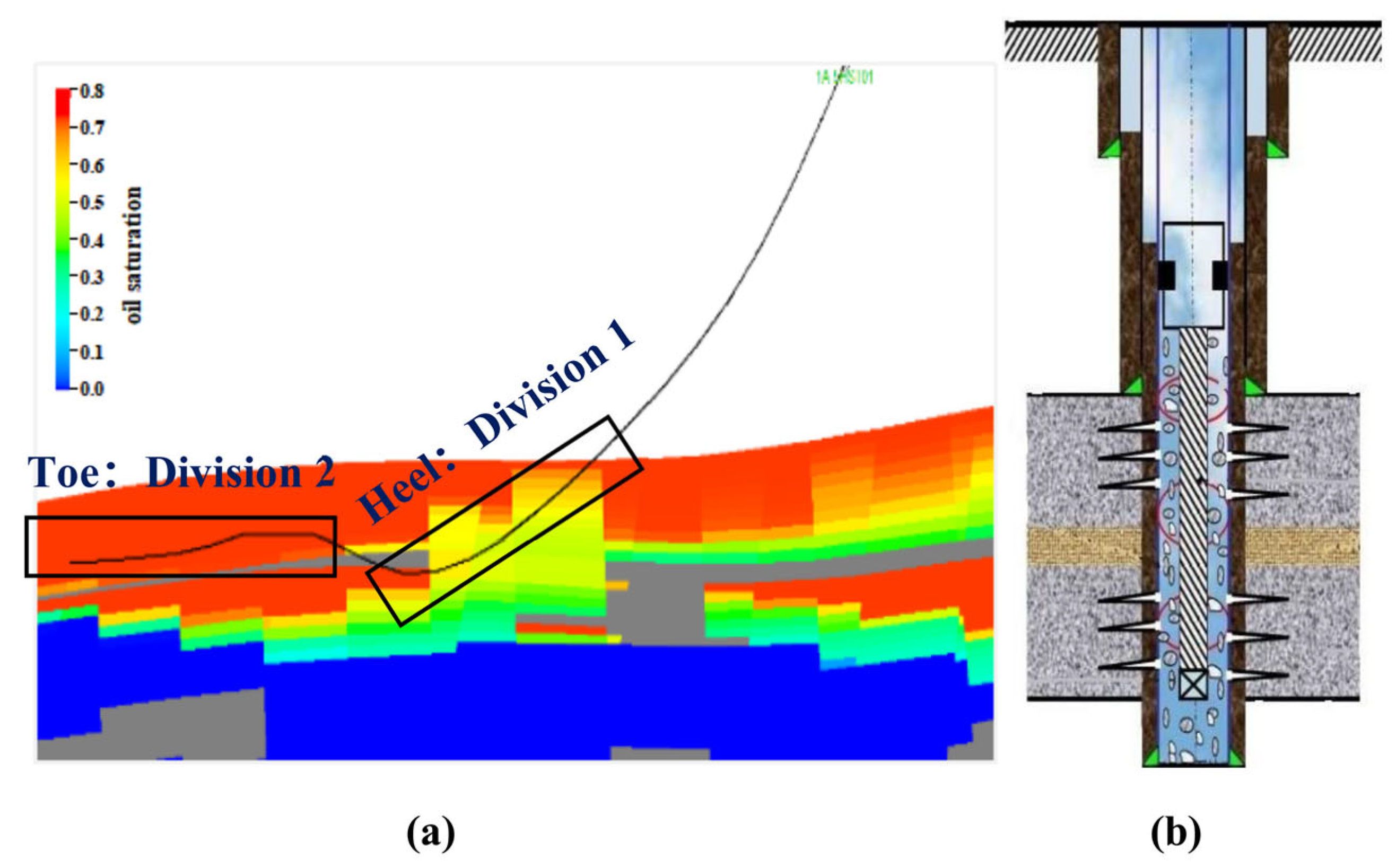


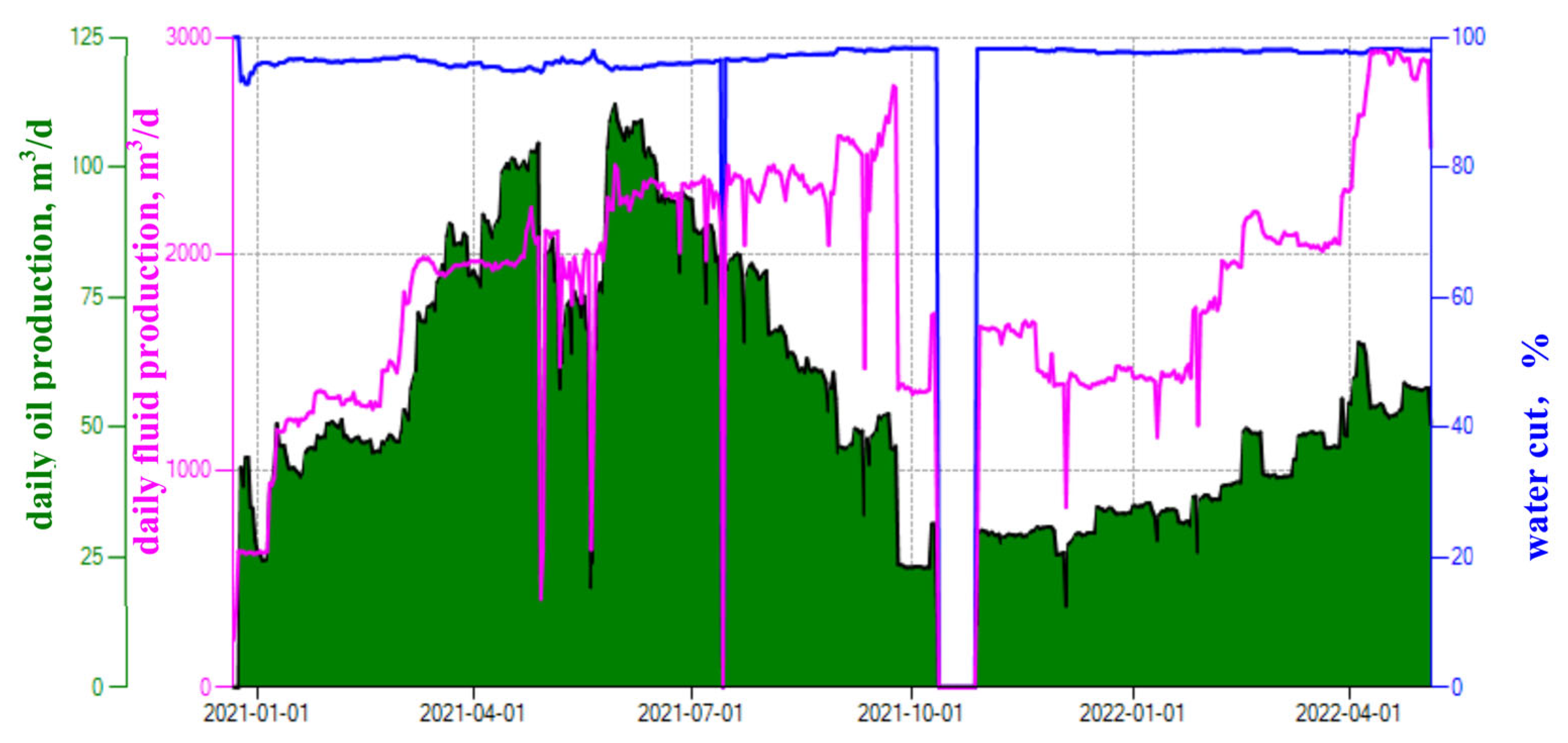
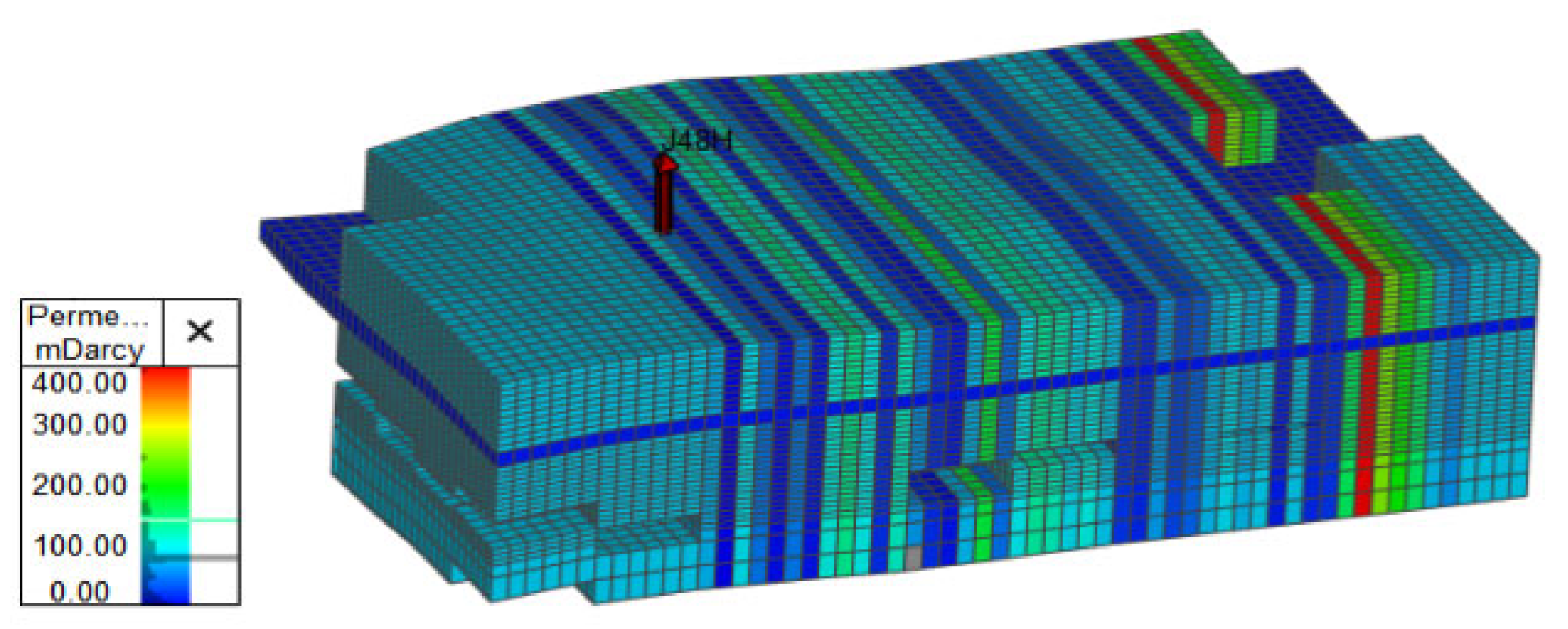
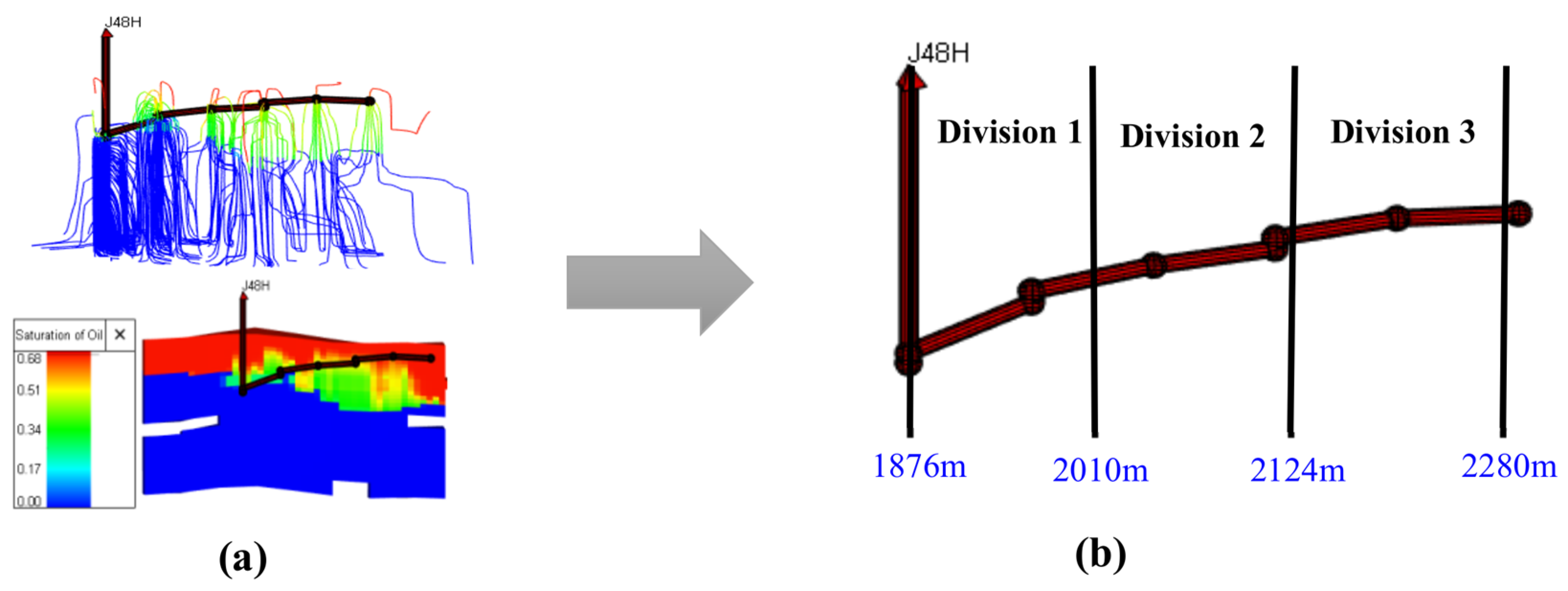

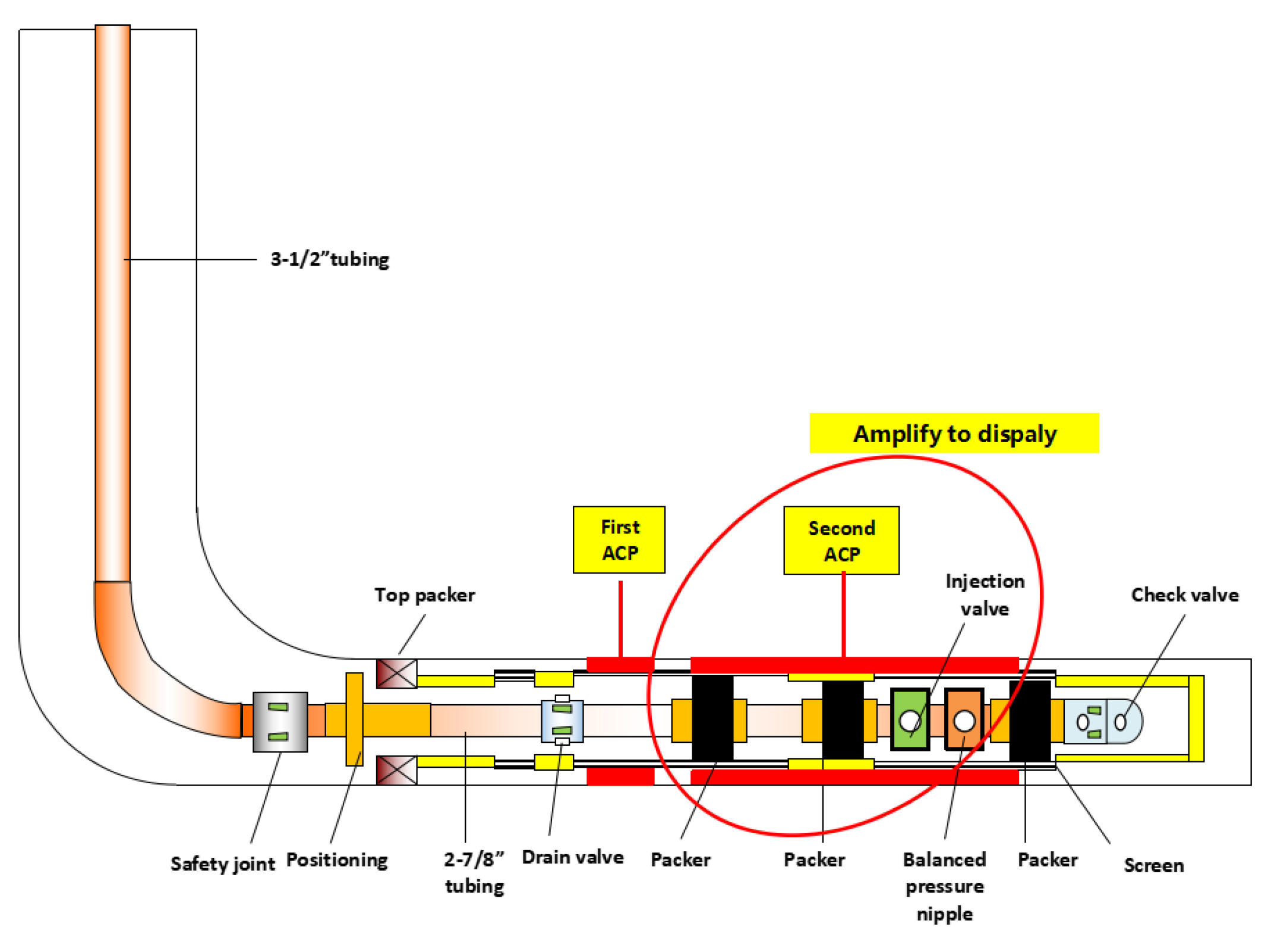
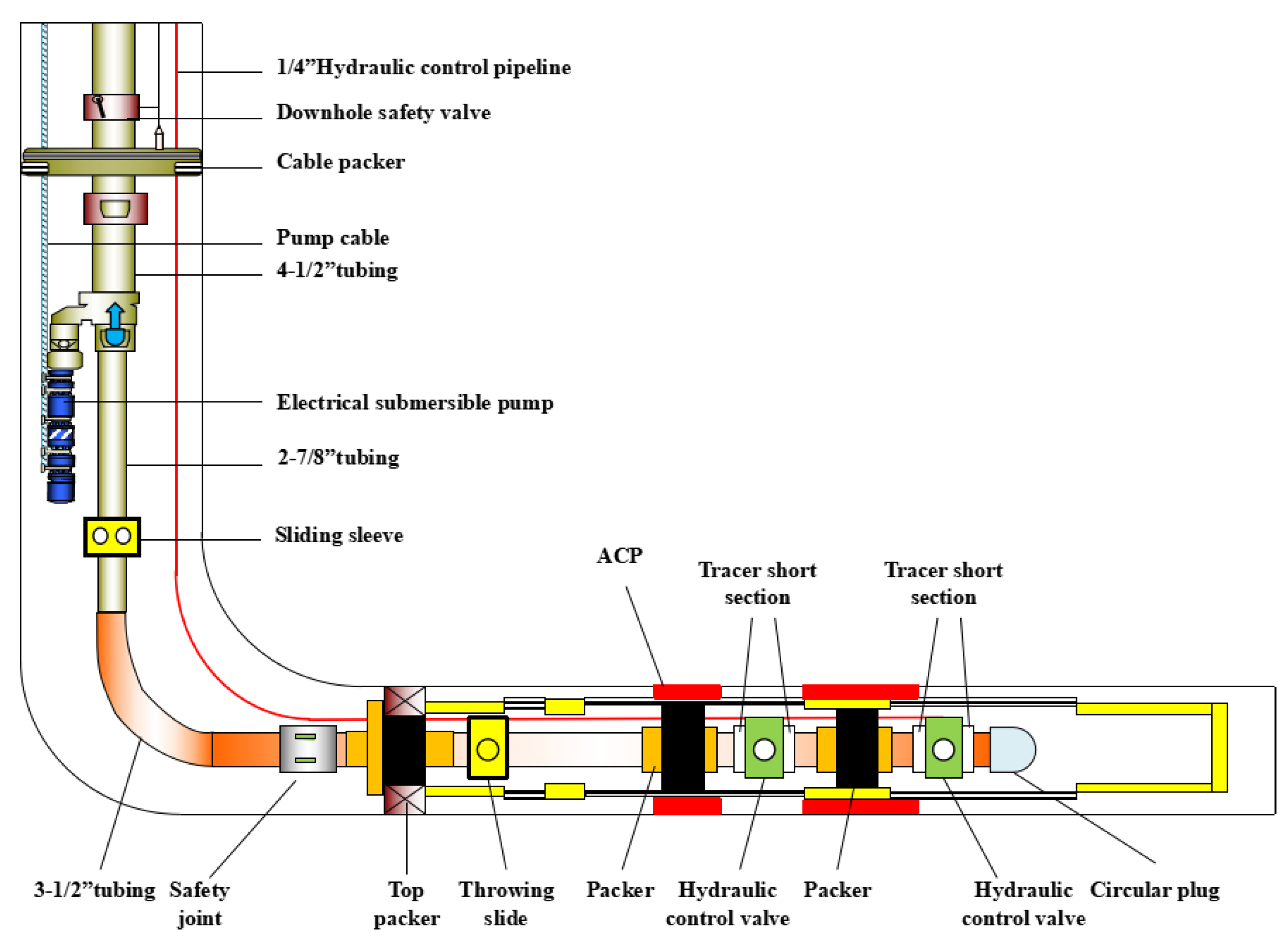


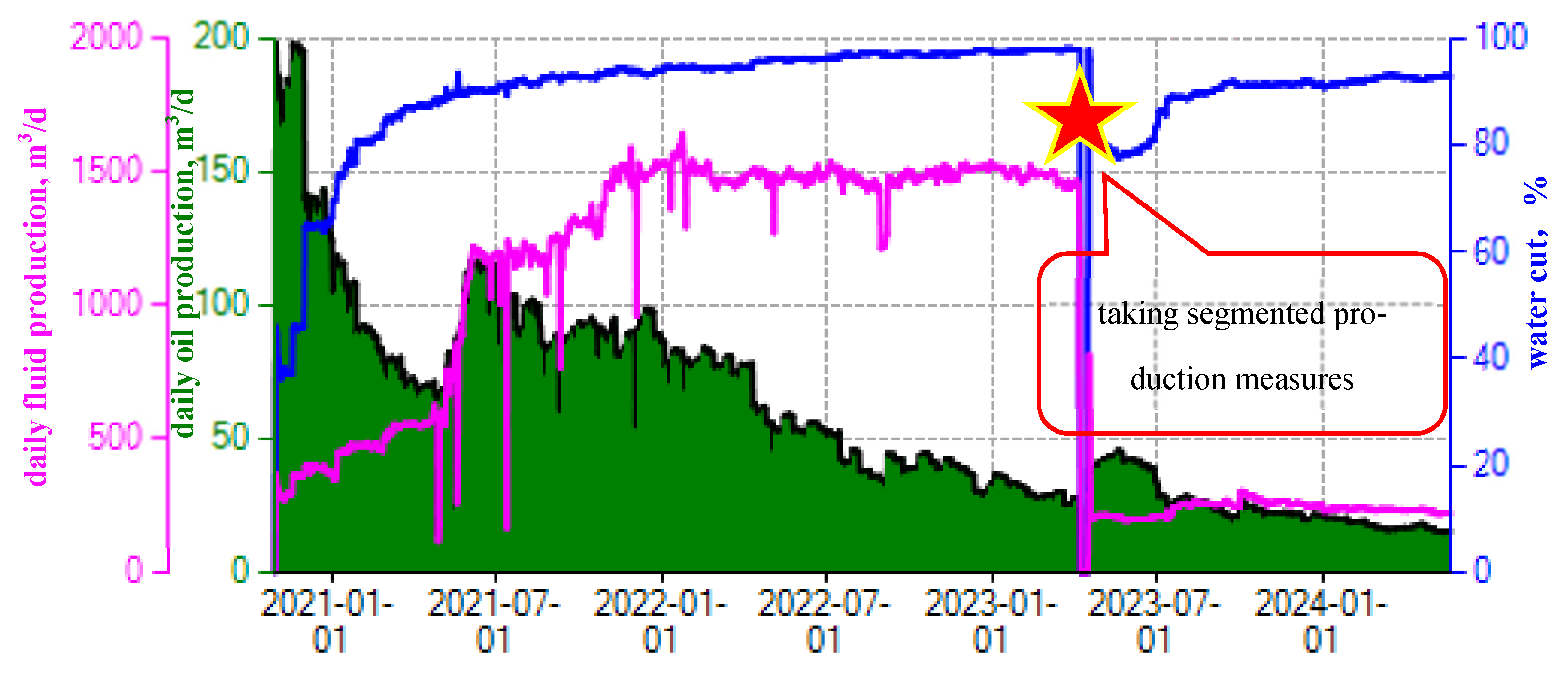
| Stratigraphic Horizon | Oil Column Height, m | Permeability, mD | Crude Oil Viscosity, mPa·s | Reserve Proportion, % |
|---|---|---|---|---|
| N1mu | 15 | 5793 | 200–450 | 37 |
| N1mL | 12 | 4128 | 50–150 | 23 |
| N1gⅢ | 10 | 1607 | 1~30 | 40 |
| Oil viscosity mPa·s | Oil density g/cm3 | Oil layer thickness m | Vertical-to- horizontal permeability ratio | Water avoidance height m | Boundary conditions |
| 30 | 0.89 | 20 | 0.1 | 16~18 | Carte-Tracy model |
| Horizontal -well length m | Porosity % | Permeability 10−3μm2 | Model dimension | Grid size m | Location of water bodies |
| 480 | 25 | 800(av) | 80 × 40 × 40 | 25 × 25 × 1 | bottom |
| Well No | Daily Oil Production, m3 | Daily Liquid Production, m3 | Water Cut, % | Net Oil Increase, m3 | |||||
|---|---|---|---|---|---|---|---|---|---|
| Before Taking Measures | After Taking Measures | Before Taking Measures | After Taking Measures | Liquid Decrease Factor | Before Taking Measures | After Taking Measures | Water Cut Decrease | Net-Water-Content-Reduction Method | |
| M1H | 58 | 48 | 2866 | 414 | 5.9 | 98.0 | 88.5 | 9.5 | 39 |
| M2H | 27 | 46 | 1446 | 205 | 6.1 | 98.1 | 77.8 | 20.3 | 42 |
| M3H | 54 | 66 | 1808 | 1516 | 0.2 | 97.0 | 95.6 | 1.4 | 21 |
| M4H | 35 | 46 | 1091 | 689 | 0.6 | 96.8 | 93.4 | 3.4 | 23 |
| M5 | 14 | 54 | 1124 | 77 | 13.6 | 98.8 | 29.8 | 69.0 | 53 |
| M6H | 41 | 19 | 1952 | 642 | 2.0 | 97.9 | 97.0 | 0.9 | 6 |
| Sub | 229 | 279 | 10,286 | 3542 | / | 97.8 | 92.1 | 5.6 | 185 |
Disclaimer/Publisher’s Note: The statements, opinions and data contained in all publications are solely those of the individual author(s) and contributor(s) and not of MDPI and/or the editor(s). MDPI and/or the editor(s) disclaim responsibility for any injury to people or property resulting from any ideas, methods, instructions or products referred to in the content. |
© 2024 by the authors. Licensee MDPI, Basel, Switzerland. This article is an open access article distributed under the terms and conditions of the Creative Commons Attribution (CC BY) license (https://creativecommons.org/licenses/by/4.0/).
Share and Cite
Zhang, D.; Li, Y.; Zhang, Z.; Li, F.; Liu, H. Research and Practice on Implementing Segmented Production Technology of Horizontal Well during Extra-High Water Cut Stage with Bottom Water Reservoir. Processes 2024, 12, 1142. https://doi.org/10.3390/pr12061142
Zhang D, Li Y, Zhang Z, Li F, Liu H. Research and Practice on Implementing Segmented Production Technology of Horizontal Well during Extra-High Water Cut Stage with Bottom Water Reservoir. Processes. 2024; 12(6):1142. https://doi.org/10.3390/pr12061142
Chicago/Turabian StyleZhang, Dong, Yanlai Li, Zongchao Zhang, Fenghui Li, and Hongjie Liu. 2024. "Research and Practice on Implementing Segmented Production Technology of Horizontal Well during Extra-High Water Cut Stage with Bottom Water Reservoir" Processes 12, no. 6: 1142. https://doi.org/10.3390/pr12061142






